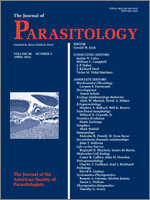Routine fecal examination revealed novel coccidian oocysts in asymptomatic California sea lions (Zalophus californianus) in a rehabilitation facility. Coccidian oocysts were observed in fecal samples collected from 15 of 410 California sea lions admitted to The Marine Mammal Center between April 2007 and October 2009. Phylogenetic analysis using the full ITS-1 region, partial small subunit 18S rDNA sequence, and the Apicomplexa rpoB region identified 2 distinct sequence clades, referred to as Coccidia A and Coccidia B, and placed them in the Sarcocystidae, grouped with the tissue-cyst–forming coccidia. Both sequence clades resolved as individual taxa at ITS-1 and rpoB and were most closely related to Neospora caninum. Coccidia A was identified in 11 and Coccidia B in 4 of 12 sea lion oocyst samples successfully sequenced (3 of those sea lions were co-infected with both parasites). Shedding of Coccidia A oocysts was not associated with age class, sex, or stranding location, but yearlings represented the majority of shedders (8/15). This is the first study to use molecular phylogenetics to identify and describe coccidian parasites shed by a marine mammal.
BioOne.org will be down briefly for maintenance on 12 February 2025 between 18:00-21:00 Pacific Time US. We apologize for any inconvenience.
How to translate text using browser tools
1 April 2012
Identification of Two Novel Coccidian Species Shed by California Sea Lions (Zalophus californianus)
Daphne Carlson-Bremer,
Christine K. Johnson,
Robin H. Miller
*,
Frances M. D. Gulland,
Patricia A. Conrad,
James D. Wasmuth,
Kathleen M. Colegrove,
Michael E. Grigg
ACCESS THE FULL ARTICLE

Journal of Parasitology
Vol. 98 • No. 2
April 2012
Vol. 98 • No. 2
April 2012




